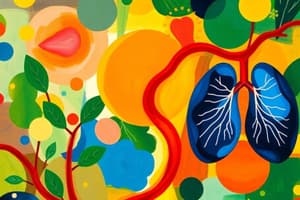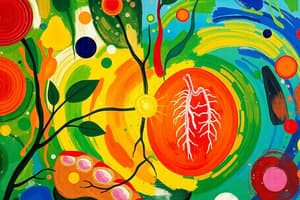Podcast
Questions and Answers
Describe the main difference between photosynthesis and cellular respiration in terms of energy conversion.
Describe the main difference between photosynthesis and cellular respiration in terms of energy conversion.
Photosynthesis converts sunlight into chemical energy, while cellular respiration releases stored energy from food molecules.
Explain the importance of energy reserves created through photosynthesis for plants during nighttime.
Explain the importance of energy reserves created through photosynthesis for plants during nighttime.
Plants rely on the reserves created through photosynthesis during daylight to meet their energy needs at night when there is no sunlight available.
What are the main products generated by cellular respiration?
What are the main products generated by cellular respiration?
The main products of cellular respiration are carbon dioxide (CO₂), water (H₂O), and heat.
Explain the process of transpiration in plants and its role in gas exchange.
Explain the process of transpiration in plants and its role in gas exchange.
Compare the main reactants involved in photosynthesis and cellular respiration.
Compare the main reactants involved in photosynthesis and cellular respiration.
Explain the relationship between chlorophyll and light energy in photosynthesis.
Explain the relationship between chlorophyll and light energy in photosynthesis.
Describe the primary difference in waste products between photosynthesis and cellular respiration.
Describe the primary difference in waste products between photosynthesis and cellular respiration.
What are the main raw materials required for cellular respiration? How are they different from those needed for photosynthesis?
What are the main raw materials required for cellular respiration? How are they different from those needed for photosynthesis?
Explain how ATP is produced in photosynthesis and cellular respiration.
Explain how ATP is produced in photosynthesis and cellular respiration.
Discuss the importance of photosynthesis and cellular respiration in maintaining the ecological balance of our planet.
Discuss the importance of photosynthesis and cellular respiration in maintaining the ecological balance of our planet.
Flashcards are hidden until you start studying
Study Notes
Photosynthesis is a process used by plants and some other organisms to convert light into chemical energy, which can later be released to fuel their activities. Cellular respiration, on the other hand, is how cells break down food molecules like glucose to release stored energy. Both processes involve the conversion of energy from one form to another, with photosynthesis converting solar energy into chemical bonds and cellular respiration breaking those chemical bonds to produce useful energy. Let's compare these two essential life processes.
Energy Comparison
Photosynthesis converts sunlight directly into chemical energy, while cellular respiration releases this stored energy when needed. In essence, photosynthesis captures sunlight, stores it within chemical compounds, and then uses it to create new compounds full of potential energy. At night, when there is no sunshine available, these plants still need energy and must rely on reserves they have created through photosynthesis during daylight hours. Meanwhile, cellular respiration breaks down complex molecules (like sugars) to release energy and generate simple molecules such as carbon dioxide (CO₂), water (H₂O), and heat. This exchange of gases between plant leaves and surrounding air is known as transpiration, where the plant takes up CO₂ and loses H₂O vapor through its pores called stomata.
Matter Comparison
During photosynthesis, green algae and land plants take in carbon dioxide (CO₂) and produce oxygen (O₂). Some plants also absorb nitrogen gas (N₂) from the atmosphere and fix it into organic forms, making them more efficient nutrient suppliers for animals that eat them. Plants make most of the O₂ we breathe; without them, Earth would likely become an uninhabitable place due to high levels of toxic waste gasses. On the contrary, cellular respiration primarily produces CO₂ as waste since it involves breaking things down instead of building them up. Additionally, the process breaks down macromolecules into smaller molecules and releases energy.
Products Comparison
In photosynthesis, the end product is molecular oxygen (O₂), carbohydrates like starch, sugar, and cellulose, plus water (H₂O) from the sunlit side of the leaf if moisture is plentiful. These materials serve as food sources for herbivorous animals; humans consume both the grass itself and livestock who graze upon it. During cellular respiration, however, the primary end products are carbon dioxide (CO₂), water (H₂O), and energy released as heat or usable in various ways depending on whether they occur aerobically or anaerobically.
Reactants Comparison
The main raw materials required for photosynthesis are chlorophyll pigment, water (H₂O), and light energy, which powers the whole process. Chlorophyll absorbs specific wavelengths of visible light—the colors red and blue—and reflects others, giving plants their characteristic green color. Carbon dioxide (CO₂) serves as the carbon source for plants, whereas oxygen (O₂) completes the reaction cycle in the presence of water vapor. For cellular respiration, glucose or glycogen is the principal substrate (foodstuff), along with oxygen (O₂). Cells require ATP for many biological functions including muscle contraction and nerve impulse transmission.
ATP Production
ATP (Adenosine Triphosphate) is produced both in photosynthesis and cellular respiration, although by different mechanisms:
- In photosynthesis, through a series of reactions involving sunlight, chlorophyll, and water, ATP is generated using energy derived from the sun.
- In cellular respiration, after breaking down glucose, part of the freed energy is converted to ATP via oxidative phosphorylation, which requires oxygen and occurs mainly in mitochondria.
Thus, both processes contribute significantly to maintaining our planet's ecological balance and providing vital resources for living creatures on Earth. While photosynthesis builds up material resources, cellular respiration recycles those materials back into their component parts to keep everything running smoothly.
Studying That Suits You
Use AI to generate personalized quizzes and flashcards to suit your learning preferences.




